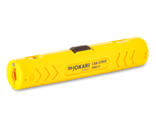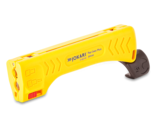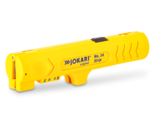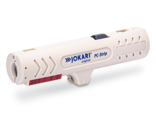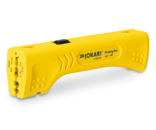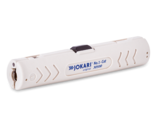JOKARI Cable Stripper
The must-have cable dismantling tool 100% Made in Germany
JOKARI cable strippers for various cable types and applications
The world of cables and wires has become very diverse in recent years. There are not only differences in size (cross-section in mm²) or diameter (ø), but also between round and flat cables. In addition, there are many different insulation materials that differ greatly in their characteristic. Whether video, data, control and sensor cables, or Ölflex® and Cat lines and many more: More and more cables and wires have to be prepared for connection, whether in industry or in handicraft. You need the right tool for this.
FAQs
Which kind of JOKARI cable strippers exist?
The JOKARI range offers different models of cable stripping tools for a wide variety of cable and line types, but also for various areas of application.
In addition to the well-known Universal cable stripper SECURA No. 15, which is mainly used as a standard cable stripper in domestic installations, users can also discover special cable strippers for data cables, such as the No. 1-Cat. The JOKARI XL makes working in deep wall outlets comfortable due to its long shape. The Allrounder can be used multifunctionally. It is suitable for stripping flat cables (up to 15mm wide) and round cables (4-15mm ø), as well as for flexible conductors (1.5-50mm2) and individual strands with 1.5mm2 or 2.5mm2. All JOKARI cable stripping machines are suitable for both left- and right-handed users.
What distinguishes a good cablestripper?
If you are about to buy a cable stripper, you should take a good look at the product. There are clear differences in terms of quality, durability and handling among the stripping tools available on the market.
The following criteria indicate a product that can be bought with a clear conscience:
Product packaging in a store should be designed so that the product is visible from the outside.
Certification marks TÜV and GS (“Tested Safety”) are an indication of the safe use of the products.
Value chain: Where does the product come from? Is it 100% Made in Germany? This worldwide known designation of origin itself is a quality criterion.
Are the product components of good and durable quality? For example, are the blades sharp and have a special coating (e. g. TiN)?
How is a cable stripping tool structured?
A cable stripper consists of two plastic shells that are joined together with a small screw, spring, or mounting clip. Depending on the application and the type of cable to be processed, one or more pairs of blades are arranged in the tools. This has to do with the condition and structure of the respective cable, e. g. thickness of the sheath or insulation material.
How does a cable stripper work?
Working with a JOKARI cable stripper is very simple. We at JOKARI call this the "JOKARI cable stripping principle":
Step 1: Insert the cable, apply slight pressure to the handle shells and turn a quarter to the right and a quarter to the left.
Step 2: Open the cable stripper, apply the knives slightly offset to the cutting point on the part of the sheath to be stripped. This step in particular is skipped by many users. However, if done correctly, it saves a lot of time and energy.
Step 3: Break the coat by briefly bending it and pull it off with the slightly closed handle - done.
On some models, a longitudinal cut can be made with the help of an additional blade. To do this, simply insert the cable into the guide, close the tool slightly and pull past the cable lengthwise. By doing so longer sections can also be stripped without any problems, as the cable can be pulled through the inside of the tool.
What are cable strippers and where are they used?
A good cable stripper is a must-have in the DIY, handicraft and industrial sectors. With this special tool, work processes in cable processing are executed quickly and safely. For stripping all kinds of cables, which nowadays are usually installed invisibly in or behind the wall (flush-mounted), a cable stripper ensures effortless work thanks to its slim, tube-like shape in these places that are difficult to access. A cable stripper is often used in wall outlet boxes or cavity wall boxes, for example. A special dismantling tool convinces with its simple application, comfortable handling and precise stripping results.
The range of wire stripping tools is huge. How do I find the right wire stripper for me?
Which wire stripping tool is most suitable to professionally process a specific cable type? The JOKARI cable database gives the right answer to this question. It supports the user in finding a professional solution quickly and easily. The user enters the cable type into the search field and receives suggestions for the right JOKARI wire stripping tool from thousands of data sets within seconds.
Further interesting information on the topic of cableknife can be found on JO!STORY, the JOKARI blog.

